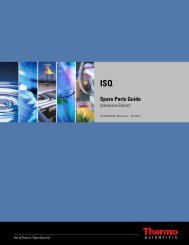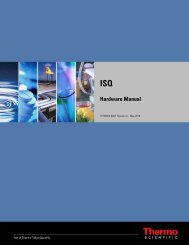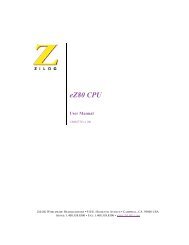ISQ User Guide - Write Frame of Mind
ISQ User Guide - Write Frame of Mind
ISQ User Guide - Write Frame of Mind
You also want an ePaper? Increase the reach of your titles
YUMPU automatically turns print PDFs into web optimized ePapers that Google loves.
4 Creating a Method<br />
b. If you have a split / splitless inlet (SSL) injector, click the SSL tab to configure the<br />
injector port settings.<br />
The inlet should be turned on and set to a temperature that is at least 10 °C<br />
higher than the boiling point <strong>of</strong> your least volatile analyte. The material injected<br />
into the port will vaporize and move into the GC column quickly. Higher<br />
temperatures can lead to thermal decomposition <strong>of</strong> some analytes, so you will<br />
have to optimize the injector temperature for your analysis. Set the SSL<br />
temperature between 50 and 375 °C (a typical value would be 225 °C).<br />
Useful for diluting high concentrations <strong>of</strong> sample, the split flow is the amount <strong>of</strong><br />
gas that is swept through the injector to the exhaust port. Higher values will give<br />
more dilution. The split flow will also reduce the amount <strong>of</strong> contamination that<br />
builds up in your system. The split flow ratio is the ratio <strong>of</strong> the split flow to the<br />
carrier gas flow. It is effectively the dilution ratio <strong>of</strong> the sample. This is typically<br />
turned on and set to a flow <strong>of</strong> 50 mL/min. However, this increases the carrier gas<br />
usage, so for your analysis, lower split flows may be more acceptable.<br />
We recommend turning on the septum purge, which means an additional 5<br />
mL/min <strong>of</strong> carrier gas will go through the injector. This reduces the buildup <strong>of</strong><br />
contaminants in the injector, on the column, and in the <strong>ISQ</strong>. If you perform a<br />
splitless injection, even if the split flow is set, the split flow will be turned <strong>of</strong>f for<br />
the splitless time. The septum purge will be turned <strong>of</strong>f for the stop purge time.<br />
After these times, the split flow and septum purge will be reactivated.<br />
Finally, if your analysis requires a higher flow to quickly sweep the analytes into<br />
the column, which may be needed with high temperature injectors and thermally<br />
labile compounds, you can use the surge pressure to increase the column flow for<br />
the surge duration time.<br />
46 <strong>ISQ</strong> <strong>User</strong> <strong>Guide</strong> Thermo Scientific






